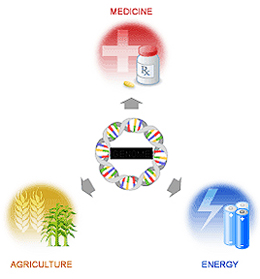By investigating the genes in the human genome, Human Genome Sciences is the world's first genomics-based pharmaceutical company, founded by none other than William Haseltine. William Haseltine is an inventor, biophysicist, professor, and above all; a leader, dedicated to the cause of scientific exploration and for the purpose of creating practical and profitable products. With its research it has found new products for diseases including lupus, colitis, cancer, and AIDS. By decoding the human genome and discovering new ways to treat these diseases, Haseltine gives patients hope that with time, they will be on the road to recovery.
On a windy autumn day (October 17, 1944) in St. Louis, Missouri, William Haseltine was born to a retired physicist and a French teacher. From his father he developed a love for science. Growing up as a boy, Haseltine wasn't certain of what he wanted to do. Haseltine grew up with three siblings at the China Lake Naval Weapons Center. He will never forget how penicillin saved his life from pneumonia. And that was when he realized that he wanted to make a difference in the world, he wanted to help people. He attended the University of California, Berkeley, BA in 1966. Seven years later he received his post-doctrine from Harvard University (1973). At Harvard, he was Chairman of two departments, the Laboratory of Biochemical Pharmacology, working on cancer treatments and the Division of Human Retrovirology, conducting AIDS research. Haseltine was a professor at Harvard Medical School (1976-1978), teaching until he found his true calling. Genetics.
William Haseltine founded Human Genome Sciences in 1992. His biotechnology career, however, began in 1980, when he founded his first company, Cambridge Bioscience. He would go on to found seven more companies, all united under the common pursuit of research. By 1992, Haseltine decided that he needed to unite his work into something deeper and founded HGSI in hopes saving countless lives. Haseltine put all that he is into Human Genome Sciences. "His founding vision, leadership and energy have both defined the Company and helped to create the new field of genomic medicine." -Max Link, Lead Director of HGSI. Along with his senior management team and group of independent Directors, the company developed promising, genomics-based products in pursuit of a healthier tomorrow.
Return to TopHaseltine began founding biotechnology companies in 1981. He saw the true potential of the new genomic sciences, and founded Human Genome Sciences with J. Craig Venter in 1992. This company was the first to dedicate itself to the research of genetics by isolating nearly all the human genes and determining the proteins made by each gene. Venter headed the Institute for Genomic Research (TIGR), the nonprofit research branch of HGSI. Haseltine and Venter believed that piecing together the entire human genome would save more people than by the conventional method of looking for individual disease-causing genes. Haseltine wanted to discover new human genes that would lead to a more efficient way of predicting, detecting, and treating human diseases. He wanted HGSI to develop its own protein-based products which were cloned from either human proteins or antibodies that could attack disease-causing proteins. Haseltine believed that by doing this, his products would be able to help us help ourselves. All his method was based on was the idea of taking our naturally occurring and nontoxic healing agents in our bodies and reinforcing our natural barriers against disease.

After founding many other companies, Haseltine gained the experience and the drive to pursue his dream of using human genomes to treat terminal diseases. For him, every life cured is a life saved. It is not only about saving a person's life- it is also about improving the conditions of their life so that they can live their life to its extent. When he founded Human Genome Sciences, Haseltine realized his lifelong dream of being able to do something that would save lives. Nothing can compare to the helpless feeling that sinks into our hearts when we discover a loved one dying and nothing is worse than knowing that there is nothing that can be done. Haseltine strives to reach a place where there are no more feelings of helplessness that every person can do something.
Return to Top- the Carter Burden Award for contributions to aging, (1995),
- the Golden Plate Award, the American Academy of Achievement, (1996),
- the Greater Washington Entrepreneur of the Year, Ernst & Young, (1996),
- the High Technology Entrepreneur of the Year, KPMG Peat Maverick, 1996,
- the 16th most influential person in the world according to Time Magazine,
- inventor of the Week for MIT
Human Genome Sciences, founded by William Haseltine is one of the first biotechnology companies to use cutting-edge genomics technologies to develop treatment. In an interview with Business Week Science Editor Ellen Licking, Chief Executive Officer William A. Haseltine discusses Human Genome Science's business model and the future of "regenerative medicine." Here are edited excerpts of their conversation:
Q: What is Human Genome Science's mission?A: Our fundamental business is to develop cures for disease using new gene-based medicines and to manufacture and sell those gene medicines to patients. Making and selling drugs, whether the drug is made from tree bark or is a gene product, is one of the oldest businesses in the world. It's also a highly successful business, because you can sell products at very high margin that are protected by government-supported monopolies, also known as patents. Furthermore, the products are ones that people really need.
Q: What kinds of products are you developing?
A: They are not "me-too" drugs. We can not only make new pharmaceutical products -- we can make better ones that are comprised of human genes, human proteins, and human antibodies. The concept is to use the body's own substances to regenerate what is damaged by disease, injured by trauma, and eventually worn by age. One gene makes one protein which is one drug which is one market. The primary market for these "regenerative medicines" is our aging population. The market for these products is the broadest possible -- it's everyone who ages.
Q: How do you go about finding your novel medicines?
A: We weren't interested in all 100,000 genes in the genome. We were interested in a specific class of genes that code for proteins that are secreted from individual cells and circulate in the body. These molecules tell cells what to do -- for instance, to grow or to die. They are probably going to be the most medically useful compounds. We automated ways to measure levels of these proteins in various tissues. We sequenced both the gene and the protein it encodes. Then, we designed highly automated cell-based assays to figure out what the proteins actually do. We have now collected data for over 10,000 genes [and their corresponding proteins]. One of our most promising targets is involved in stimulating immune function.
Q: Will your strategy improve the efficiency of drug development?
A: Yes. Our goal is to use genomics to generate 100 human leads that are active in cell-based experiments. From that we will choose 10 leads and test them in animal models. We plan to generate two new drug compounds a year, and will develop at least two of them in-house. So, with just a small budget -- $100 million annually -- we'll deliver four potential therapies a year. That's much greater efficiency than other pharmaceutical companies.
Q: Please explain your business plan and financing strategy.
A: Most people misinterpret our business plan and assume that since we sell our technical expertise to pharma that we're a service company. Instead, we invented a new financial strategy for funding our company through the lean years until we grew into a stand-alone entity. Our model for success is Amgen. Fifteen years ago, Amgen started from nothing, but was able to find, develop, and market two major drugs, called Epogen and Neupogen, on its own. To this day, no biotech company has done better than Amgen. Our model is to become just like Amgen, only with a deeper pipeline. Think what would happen if Amgen had a systematic method for discovering its drugs. It would be one of the largest pharmaceuticals in existence. Well, that's our goal.
Q: And your financing strategy?
A: Timelines in biotech are very long -- it's a major structural problem for the industry. We knew this when we started, so we conceived of a 15-year plan back in 1992 that's a new financial strategy for funding a biotech company. When we started, we decided not to pursue nonexclusive contracts with pharmaceutical companies. I feared we would become just a commodity business.
Yes, that strategy would have raised a lot of money up front, but the value down the road wouldn't have been as great. So we chose an exclusive arrangement with SmithKline Beecham that gave us $125 million up front, plus 10% of royalties from drug sales, and the right to co-develop a product in 20% of the market. That gives us a total return of 30% just for collaborating with SKB. We quickly saturated SmithKline's ability to handle targets and have since expanded our web of alliances to include Merck, Takeda, and others. This has allowed us to raise $300 million to cover research costs.
The result: Our balance sheet is cash-neutral.
Return to Top



